| Why
this website?
In this website, an ongoing work in progress, we present a living
history that documents, honors, discovers, and connects with today.
We begin by connecting art, education (formal and informal) and community,
focusing on unique aspects of Silicon
Valley and the Bay Area cultural/educational scene in the last six
or more decades.
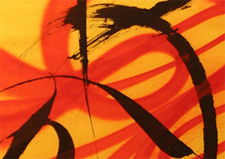 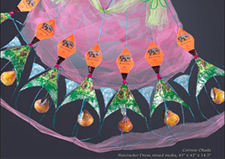
I work collaboratively. "We" refers to the fellow cultural workers,
academics across disciplines, colleagues, activists, and others I
have worked with who enjoy sharing art and ideas. Acknowledging and
honoring these talented people is important to me, so I write with
all of them in mind.
Silicon Valley has been a crucible for start-up organizations of all
kinds, including the arts. Start-up arts organizations, such as the
Euphrat Museum of Art, with 33 years of its long history detailed here, are an important cultural resource, a stimulant
for creativity and innovation. Many individuals and organizations
have not had the time or the resources to record accomplishments,
ideas, and insights, particularly in the decades before computers
and the widespread use of the Internet. Our intent is to provide extra
information to assist others who may be researching these past decades
to view progression of artists, ideas, innovation, and organizations
in Silicon Valley. Many of these artists and groups are flourishing
today, tilling new ground. Our updates and dialog can provide continuity,
encouragement and opportunity, opening new doors for future artists
and arts organizations.
The
Importance of Archives, 1981
Introductory essay, Jan Rindfleisch, 1981, for Staying
Visible, The Importance of Archives, produced in conjunction
with Euphrat Museum of Art exhibition. The concepts and questions
are relevant today.

|
"It takes work, lots of it,
to keep artwork and artists visible… Talent alone, 'good
work,'
is no assurance
of anything."
- Michael
Bell |
Book cover art is Agnes Pelton,
Orbits, 1934. Collection
of the Oakland Museum. Gift of Concours d'Antiques, Art Guild, The
Oakland Museum Association.
Purposes
This project began two years ago. Its purposes were to search California
and national archives and find out what information was already available
about several neglected artists; to collect more information; to make
a challenging and visually exciting gallery show from the project;
to put the newly acquired information in the archives (so that others
would have the chance to review this work, and find something more
than we found) — and to publicize the importance of "saving
stuff" in keeping an artwork, and an artist, visible.
We have had our ups and downs. The stories are many. They tell of
some of the problems of research and recognition — why A is
remembered and B is not.
I approached The Archives of California
Art at The Oakland Museum,
and I started working with Michael
Bell, then Registrar/Cataloguer for the Oakland Museum Art
Department; with George Neubert,
then Chief Curator for Art at The Oakland Museum; and with three graduate
students from San Jose State University. Within eighteen months, problems
with money, families and jobs changed the working group almost entirely.
The Oakland Museum was in financial straits as were so many other
public institutions in 1980, and the graduate researchers themselves
faced a variety of pressures.
While some researchers were forced to leave, others appeared on the
scene, and I increased the number of artists to eleven in order to
include contemporary San Francisco Bay Area artists whose media, backgrounds,
and art-world ties were different from mainstream art and/or from
each other. The diversity of artists is important. It awakens us to
the variety of what can get lost from the records: a portion of a
famous artist's life or work; the historical/critical significance
of the artist, once "in favor," who has since been neglected by critics
and curators; the life and work of the isolated artist, the artist
with several careers, and the non-traditional artist whose visibility
is subject to the vagaries of what a fine artist is and is not.
The diversity of researchers is also important. The new researchers
for these additional artists were not all graduate students but were
connected to the artists in various, and often more intimate, ways:
artist colleagues, art historians, close friends, co-workers, mentors,
or admirers from other fields. Each researcher had a different relationship
with her or his artist. Each researcher had different motivations,
commitments, job pressures, and a different approach and view of their
involvement. These factors invite consideration of the human
element of decision-making in the arts. The list of great artists,
which we learned in elementary school or in art history classes, did
not drop from heaven but was the result of decisions by such real
people.
At first the researchers often asked me: What kind of "stuff" do you
want? What gets written? What gets saved? I responded with a list
of facts and possible items, but left many decisions to the artists
and researchers. I like surprises and I wanted connections to come
naturally rather than be artificially imposed. I imagined myself inundated
with old photos; stacks of letters, postcards, birthday cards; memorabilia,
from palettes to visual aids around the studio; bills, contracts;
rough drafts; posters, mailers, reviews; interviews, taped and transcribed;
sketchbooks and journals of artists and researchers; the standard
resumes; and so on and on. I already knew that the painter Barbara
Rogers was going to present me with a box of old gallery announcements
she had saved.
Philosophical
Guidelines
Our philosophical guidelines were simple: "Archives save everything;
others decide later what is important."
But we soon discovered the problems of archivists: How much
time, space, effort, and money were we practically willing or able
to invest? Furthermore, many artists, and even researchers, were not
willing to give original papers to the archives (at least not yet),
but were willing to have these copied. We soon had tables full of
photocopies and tape duplications.
Also, although archivists may want to save everything, artists don't
always want to give everything. Some artists do not want their personal
letters to go anywhere or be copied. Some do not want certain "personal"
facts related, even though such facts might explain much about their
work. While some artists are candid, others are afraid to be quoted
or speak their minds. Marjorie Eaton,
an artist represented here, says she once gave a museum a list of
people she thought it would be proper to acknowledge as influential.
A critic twisted this gesture and said Eaton should make up her mind
about whom she wanted to copy.
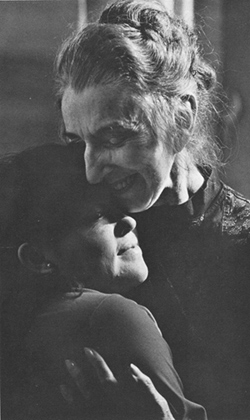
Marjorie Eaton with her
godchild. Photo: Hella Hammid.
The difference between art, archival material ("papers") and
memorabilia and the significance of their cohabitation in archives
were not always clear to us. Preliminary drawings, sketchbooks, taped
interviews, and photographs are put into many archives. But "preliminary"
drawings, sketchbooks, and photographs are often considered finished
works of art, and taped interviews can be performance art. And what
about the decorated envelope sent from artist Bettye
Saar to Mildred Howard?
The watercolor Easter card sent from Consuelo
Cloos to Marjorie Eaton?
The calligraphic poem sent from Jim
Rosen to Fay Evans?
How about the lotería
cards Carmen Lomas Garza's
mother made, clearly an inspiration and source for Garza's lotería
etchings? What are the advantages, disadvantages, and implications
for the future life of these things, housed alongside documents in
an archive? (And if some art is included, why not all?)
Underpinnings
It was exciting to discover, collect, save and share … to put
things in archives is to preserve more than we know. Art history is
based on facts, and archives often hold "the proof." They are the
"underpinnings" of our statements.
We felt an importance in our work. Paul
Karlstrom's [West Coast Area Director,
Archives of American Art, Smithsonian Institution] foreword
underlines this feeling. He wrote that the goal of archival activity
was "to fill in the many gaps and omissions resulting from contemporary
curatorial and critical selectivity."
Karlstrom voiced our feelings again when he wrote that many serious
California artists complain that they are "locked out" of an art establishment
network; that there is an absence of a literature devoted to contemporary
art communities in California.
Geographical bias, however, is not the only reason why many artists
in California feel they are "locked out" of the art establishment
and "written out" of history books. Many sense exclusion because of
race, gender, nationality, religion… or individual quirks. Motivation,
for many of the researchers and artists, was the chance to add to
art history.
This is important, that we can add to art history and even become
a part of it. Art people can make their own archives: save announcements
and letters, take the step from boxes of papers to the two-drawer
filing-cabinet system, progress to taking photographs and making audiotapes.
Not only can art people "save their stuff," they can record other
art people. They can speak to the historical consciousness and responsibility
of the art community and the local community…
…
often quite imaginatively. Patricia
Rodriguez artfully documents herself, Garza, and other Chicanas
by combining plaster masks of their faces with some of their memorabilia.
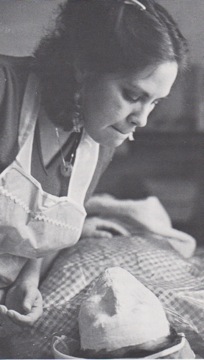
Patricia Rodriguez making
a mask of Irene Perez, 1980.
Garza saves and pays tribute to the art of her mother in the lotería
etchings. Rosen writes a poem to Evans and letters to museums to have
Evans's work purchased. Mildred Howard
creates historical collages.
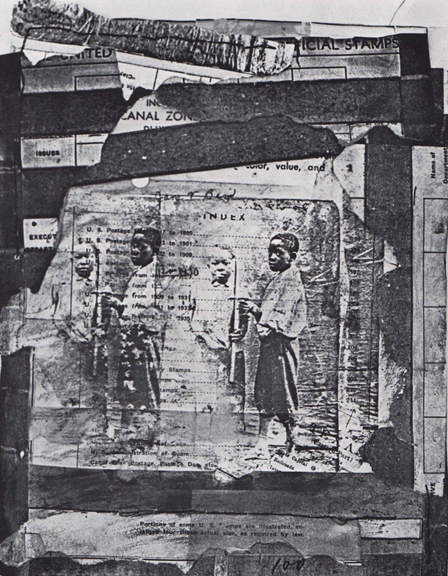
Mildred Howard, Untitled,
from the series Last Train
from Dixie and $1.25, 1979-80. Mixed media collage, 11"x8.5".
The "$1.25" refers to the state of her parents' finances when they
arrived in the Bay Area from Texas. Includes stitching, photos of
relatives copied in warm tones, and stamp images from Africa and the
U.S.
Photo: Donna Larsen
Katherine
Huffaker and Therese May
collaborate and record each other's art by making more art. Margaret
Stainer is a non-stop letter writer and keeps a journal of
her research on Agnes Pelton.
During their lives, art people need to attend to art and papers, to
protect them from flood, fire, chaotic housekeeping, and more deliberate
destruction; later these items need to be protected from unknowing
or uncaring relatives, friends, and/or neighbors. It behooves us to
keep our "papers" and art in order. As Beatrice
Wood says about invoices (see her interview, page 13), it is
important to keep daily business in hand or we will not know freedom…
"Laziness is no excuse," Michael Bell used to say to me. It
takes work, lots of it,
to keep artwork and artists visible. The necessary components are
time, money and a strong belief and commitment by someone to get an
artist in a history book, a museum collection, or a major exhibition.
Talent alone, "good work," is no assurance of anything.
Yet how many of us are saving our correspondence? How many keep a
"three-line" diary like Beatrice Wood?
Questions
Continue
We have learned much, yet the questions continue.
We
were putting things in archives. And I wondered who else puts things
in…and what kinds of things are not accepted, not considered
worthy of documentation. Once quilts were not accepted as a fine art
form. How well are quilt makers documented in various art archives
today? What about cartoonists or commercial artists? or Leila
Macdonald who made a robe from fabric scraps? Selectivity is
a critical issue. In order to understand the art of any period, all
the art activity must be documented, not just that of a few
people; a wide-open range of papers must be saved, not just artists'.
Karlstrom told me that the Archives of American Art at the De
Young Museum in San Francisco did not have a "master list"
of who was to be included; that they received recommendations from
a network of consultants; that they "tried to distort history as little
as possible;" that they sought out information. But how much effort
goes to seeking out diversity?
How many artists (especially if they are not attached to an institution)
know about archives? How many get their visual products documented
and secured?
More information needs to get out about the existence and uses, the
importance of archives. In addition to the state and national archives,
there are many art archives around, with many purposes. In the San
Francisco Bay vicinity, examples of smaller archives are the Contemporary
Art Archives at La Mamelle,
Inc.; the growing archives at the Galeria
de la Raza; the personal archives of Jan
Butterfield, Associate Editor of Images
and Issues, who is writing a book on emerging California artists;
the files of gallery artists at the Center
for Visual Arts, Oakland; the Women
Artists' Archives at Sonoma
State University; the library files at the San
Francisco Museum of Modern Art.
Awareness of these and other archives presents us with a dilemma of
where we might deposit our research materials, since we qualify in
many areas. Touch of the "real thing" is important — this is
possible at the Archives of California Art. However, discussions between
researchers, galleries, artists and other potential donors have not
finalized the placement of primary source material. Of course we will
coordinate with all archives for which this material is a vital addition.
We are still learning how different archives cooperate with one another,
the tug-of-war between "pride of possession" and the realization that
no one has the space to hold everything or receives consistent "A"
grades on preservation and accessibility.
Questions about information glut, creative filing, problems and benefits
of photocopy machines, use of computers, varieties of researchers'
styles, the importance of touching "the real thing" versus using microfilm,
the importance of proper care of primary sources, the attitude "the
art work stands by itself" without label or context — these
questions are too large to confront here, but demand continued discussion.
We confronted them. One way or another they touch the future visible
life of every artist in this book.
|
